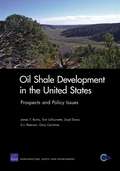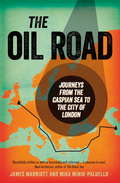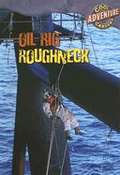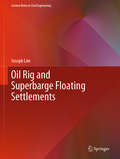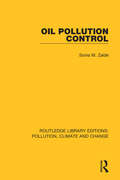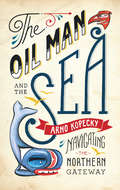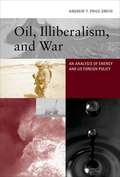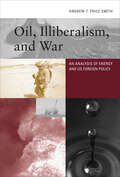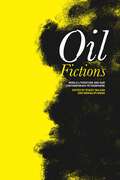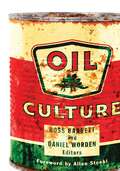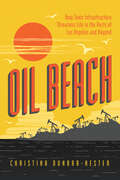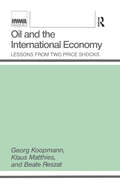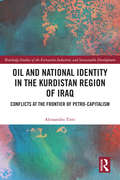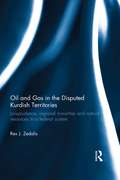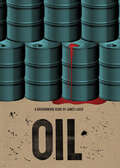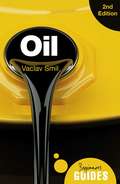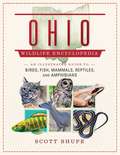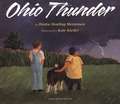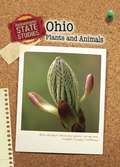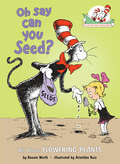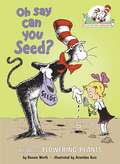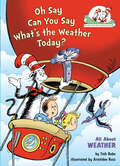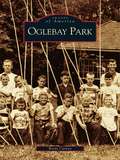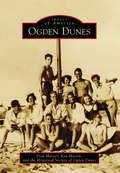- Table View
- List View
Oil Shale Development in the United States
by Tom Latourrette James T. Bartis Gary Cecchine D. J. Peterson Lloyd DixonIn the early 1980s, industry and government took a hard look at the economics of extracting oil from vast deposits of shale that lie beneath the western United States. Oil prices subsided, and interest waned. With oil prices spiking and global demand showing no signs of abating, reexamining the economics of oil shale makes sense. In this report, the authors describe oil shale resources; suitability, cost, and performance of new technologies; and key policy issues that need to be addressed by government decisionmakers in the near future.
The Oil Road
by Mika Minio-Paluello James MarriottFrom Caspian drilling rigs and Caucasus mountain villages to Mediterranean fishing communities and European capitals, this is a journey through the heart of our oil-obsessed society. Blending travel writing and investigative journalism, it charts a history of violent confrontation between geopolitics, profit and humanity. From the revolutionary futurism of 1920s Baku to the unblinking capitalism of modern London, this book reveals the relentless drive to control fossil fuels. Harrowing, powerful and insightful, The Oil Road maps the true cost of oil.
Oil Rig Roughneck (Cool Adventure Careers)
by Geoffrey M. HornThe first group of titles in an ongoing series introduces students to six amazing adventure careers. Geared for reluctant readers in upper elementary school and above, each high-interest title combines easy-to-follow text with engaging on-the-job photos to spark students' interest in reading and career exploration. Each book is filled with descriptive information about the career, along with the skills and requirements needed to pursue a job in the profiled field.
Oil Rig and Superbarge Floating Settlements (Lecture Notes in Civil Engineering #82)
by Joseph LimThis book presents a collection of proposed offshore and nearshore settlements in response to the emerging consequences of climate change. These settlements are counterpoints to megacities with unsustainable ecological footprints. The continuing depletion of natural resources has resulted in displaced communities, prompting the following research questions: What if we floated on sea instead of inefficiently consuming land? Could we use wave energy instead of nuclear energy? How can we replenish food supply and regenerate marine eco-diversity? How would our lives be shaped by new offshore settlements? What would we use as structures for shelter, farming, scaffolding and recreation? Floating cities emerged in the 1960s with Buckminster Fuller’s Triton City and Kenzo Tange’s Tokyo Bay Plan, and current manifestations include Vincent Callebaut’s Lilypad, the Seasteading Institute and the mile-long Freedom Ship housing 50,000 people. As an alternative to these examples, the book proposes the repurposing of three types of marine vessel: jack-up platforms, semi-submersibles and superbarges as sustainable, habitable structures to accommodate 20% of the projected 8.1 billion global population in 2025. The spatially conceived floating settlements include food and energy supplies for housing, recreation, education at sea, post-disaster health care and resettlement for nearshore deployment.
Oil Pollution Control
by Sonia M. ZaideOil pollution has been a major environmental concern since the 1920s. The search for a solution has ranged from prevention to partial measures coupled with compensation and remedial action. This book, originally published in 1987, offers a different assessment of the efforts of governments and the oil and maritime industries. It was also the first book to provide a comprehensive story of control policies and practices, using primary and secondary sources. The book identified numerous factor – personalities, state policies, developments in the oil and shipping industries, public agitation and scientific studies in a framework useful for analysing any environmental problem.
The Oil Man and the Sea: Navigating the Northern Gateway
by Arno KopeckyA sailing trip along the proposed Northern Gateway marine route with a fresh new voice in non-fiction.With oil and gas behemoth Enbridge Inc.'s Northern Gateway proposal nearing approval, supertankers loaded with two million barrels of oil may soon be plying the waters from northern British Columbia down the wild Pacific Coast. <P><P>This region is home to the largest tract of temperate rainforest on earth, First Nations who have lived there for millennia, and some of the world's most biodiverse waters-one spill is all it will take to erase ten thousand years of evolution.Arno Kopecky and his companions travel aboard a forty-one-foot sailboat exploring the pristine route-a profoundly volatile marine environment that registered 1,275 marine vessel incidents-mechanical failures, collisions, explosions, groundings, and sinkings-between 1999 and 2009 alone. Neither Kopecky nor the boat's owner have ever sailed before, yet they brave these waters alone when their captain leaves them part way through the journey.Written with Kopecky's quick humor and deft touch, this is a rich evocation of a mythic place and the ecology, culture, and history of a legendary region with a knife at its throat.
Oil in the Environment
by John A. WiensWhat light does nearly 25 years of scientific study of the Exxon Valdez oil spill shed on the fate and effects of a spill? How can the results help in assessing future spills? How can ecological risks be assessed and quantified? In this, the first book on the effects of Exxon Valdez in 15 years, scientists directly involved in studying the spill provide a comprehensive perspective on, and synthesis of, scientific information on long-term spill effects. The coverage is multidisciplinary, with chapters discussing a range of issues including effects on biota, successes and failures of post-spill studies and techniques, and areas of continued disagreement. An even-handed and critical examination of more than two decades of scientific study, this is an invaluable guide for studying future oil spills and, more broadly, for unraveling the consequences of any large environmental disruption. For access to a full bibliography of related publications, follow the Resources link at www. cambridge. org/9781107027176.
Oil, Illiberalism, and War
by Andrew T. Price-SmithThe United States is addicted to crude oil. In this book, Andrew Price-Smith argues that this addiction has distorted the conduct of American foreign policy in profound and malign ways, resulting in interventionism, exploitation, and other illiberal behaviors that hide behind a facade of liberal internationalism. The symbiotic relationship between the state and the oil industry has produced deviations from rational foreign energy policy, including interventions in Iraq and elsewhere that have been (at the very least) counterproductive or (at worst) completely antithetical to national interests.Liberal internationalism casts the United States as a benign hegemon, guaranteeing security to its allies during the Cold War and helping to establish collaborative international institutions. Price-Smith argues for a reformulation of liberal internationalism (which he terms shadow liberalism) that takes into account the dark side of American foreign policy. Price-Smith contends that the "free market" in international oil is largely a myth, rendered problematic by energy statism and the rise of national oil companies. He illustrates the destabilizing effect of oil in the Persian Gulf, and describes the United States' grand energy strategy, particularly in the Persian Gulf, as illiberal at its core, focused on the projection of power and on periodic bouts of violence. Washington's perennial oscillation between liberal phases of institution building and provision of public goods and illiberal bellicosity, Price-Smith argues, represents the shadow liberalism that is at the core of US foreign policy.
Oil, Illiberalism, and War: An Analysis of Energy and US Foreign Policy (The\mit Press Ser.)
by Andrew T. Price-SmithAn argument that America's addiction to crude oil has driven a foreign policy of intervention and exploitation hidden behind a facade of liberal internationalism.The United States is addicted to crude oil. In this book, Andrew Price-Smith argues that this addiction has distorted the conduct of American foreign policy in profound and malign ways, resulting in interventionism, exploitation, and other illiberal behaviors that hide behind a facade of liberal internationalism. The symbiotic relationship between the state and the oil industry has produced deviations from rational foreign energy policy, including interventions in Iraq and elsewhere that have been (at the very least) counterproductive or (at worst) completely antithetical to national interests.Liberal internationalism casts the United States as a benign hegemon, guaranteeing security to its allies during the Cold War and helping to establish collaborative international institutions. Price-Smith argues for a reformulation of liberal internationalism (which he terms shadow liberalism) that takes into account the dark side of American foreign policy. Price-Smith contends that the “free market” in international oil is largely a myth, rendered problematic by energy statism and the rise of national oil companies. He illustrates the destabilizing effect of oil in the Persian Gulf, and describes the United States' grand energy strategy, particularly in the Persian Gulf, as illiberal at its core, focused on the projection of power and on periodic bouts of violence. Washington's perennial oscillation between liberal phases of institution building and provision of public goods and illiberal bellicosity, Price-Smith argues, represents the shadow liberalism that is at the core of US foreign policy.
Oil Fictions: World Literature and Our Contemporary Petrosphere (AnthropoScene)
by Stacey Balkan and Swaralipi NandiOil, like other fossil fuels, permeates every aspect of human existence. Yet it has been largely ignored by cultural critics, especially in the context of the Global South. Seeking to make visible not only the pervasiveness of oil in society and culture but also its power, Oil Fictions stages a critical intervention that aligns with the broader goals of the energy humanities.Exploring literature and film about petroleum as a genre of world literature, Oil Fictions focuses on the ubiquity of oil as well as the cultural response to petroleum in postcolonial states. The chapters engage with African, South American, South Asian, Iranian, and transnational petrofictions and cover topics such as the relationship of colonialism to the fossil fuel economy, issues of gender in the Thermocene epoch, and discussions of migration, precarious labor, and the petro-diaspora. This unique exploration includes testimonies of the oil encounter—through memoirs, journals, and interviews—from a diverse geopolitical grid, ranging from the Permian Basin to the Persian Gulf.By engaging with non-Western literary responses to petroleum in a concentrated, sustained way, this pathbreaking book illuminates the transnational dimensions of the discourse on oil. It will appeal to scholars and students working in literature and science studies, energy humanities, ecocriticism, petrocriticism, environmental humanities, and Anthropocene studies.In addition to the editors, the contributors to this volume include Henry Obi Ajumeze, Rebecca Babcock, Ashley Dawson, Sharae Deckard, Scott DeVries, Kristen Figgins, Amitav Ghosh, Corbin Hiday, Helen Kapstein, Micheal Angelo Rumore, Simon Ryle, Sheena Stief, Imre Szeman, Maya Vinai, and Wendy W. Walters.
Oil Culture
by Daniel Worden Ross BarrettIn the 150 years since the birth of the petroleum industry oil has saturated our culture, fueling our cars and wars, our economy and policies. But just as thoroughly, culture saturates oil. So what exactly is "oil culture"? This book pursues an answer through petrocapitalism's history in literature, film, fine art, wartime propaganda, and museum displays. Investigating cultural discourses that have taken shape around oil, these essays compose the first sustained attempt to understand how petroleum has suffused the Western imagination.The contributors to this volume examine the oil culture nexus, beginning with the whale oil culture it replaced and analyzing literature and films such as Giant, Sundown, Bernardo Bertolucci's La Via del Petrolio, and Ben Okri's "What the Tapster Saw"; corporate art, museum installations, and contemporary photography; and in apocalyptic visions of environmental disaster and science fiction. By considering oil as both a natural resource and a trope, the authors show how oil's dominance is part of culture rather than an economic or physical necessity. Oil Culture sees beyond oil capitalism to alternative modes of energy production and consumption.Contributors: Georgiana Banita, U of Bamberg; Frederick Buell, Queens College; Gerry Canavan, Marquette U; Melanie Doherty, Wesleyan College; Sarah Frohardt-Lane, Ripon College, Matthew T. Huber, Syracuse U; Dolly Jørgensen, Umeå U; Stephanie LeMenager, U of Oregon; Hanna Musiol, Northeastern U; Chad H. Parker, U of Louisiana at Lafayette; Ruth Salvaggio, U of North Carolina, Chapel Hill; Heidi Scott, Florida International U; Imre Szeman, U of Alberta; Michael Watts, U of California, Berkeley; Jennifer Wenzel, Columbia University; Sheena Wilson, U of Alberta; Rochelle Raineri Zuck, U of Minnesota Duluth; Catherine Zuromskis, U of New Mexico.
Oil Beach: How Toxic Infrastructure Threatens Life in the Ports of Los Angeles and Beyond
by Christina Dunbar-HesterCan the stories of bananas, whales, sea birds, and otters teach us to reconsider the seaport as a place of ecological violence, tied to oil, capital, and trade? San Pedro Bay, which contains the contiguous Ports of Los Angeles and Long Beach, is a significant site for petroleum shipping and refining as well as one of the largest container shipping ports in the world—some forty percent of containerized imports to the United States pass through this so-called America’s Port. It is also ecologically rich. Built atop a land- and waterscape of vital importance to wildlife, the heavily industrialized Los Angeles Harbor contains estuarial wetlands, the LA River mouth, and a marine ecology where colder and warmer Pacific Ocean waters meet. In this compelling interdisciplinary investigation, award-winning author Christina Dunbar-Hester explores the complex relationships among commerce, empire, environment, and the nonhuman life forms of San Pedro Bay over the last fifty years—a period coinciding with the era of modern environmental regulation in the United States. The LA port complex is not simply a local site, Dunbar-Hester argues, but a node in a network that enables the continued expansion of capitalism, propelling trade as it drives the extraction of natural resources, labor violations, pollution, and other harms. Focusing specifically on cetaceans, bananas, sea birds, and otters whose lives are intertwined with the vitality of the port complex itself, Oil Beach reveals how logistics infrastructure threatens ecologies as it circulates goods and capital—and helps us to consider a future where the accumulation of life and the accumulation of capital are not in violent tension.
Oil and the International Economy
by Georg Koopmann Klaus Matthies Beate ReszatThe oil price increases of the 1970s left deep marks on the world economy. They led to a massive redistribution of income in favor of oil-producing countries, and caused serious disruption of growth, imbalances in foreign trade, and problems of stability in oil-importing countries. Despite the present levelling off, the authors suggest that more price increases remain a distinct possibility.Oil and the International Economy examines the effects of rising oil prices on the international financial system and identifies ways that oil-importing countries can overcome the financial and adjustment problems caused by them. The authors project the long-term trend in real oil prices and present economic policy options to help avoid future financial problems for industrialized and developing nations alike.
Oil and National Identity in the Kurdistan Region of Iraq: Conflicts at the Frontier of Petro-Capitalism (Routledge Studies of the Extractive Industries and Sustainable Development)
by Alessandro TintiExamining the interplay between the oil economy and identity politics using the Kurdistan Region of Iraq as a case study, this book tells the untold story of how extractivism in the Kurdish autonomous region is interwoven in a mosaic of territorial disputes, simmering ethnic tensions, dynastic rule, party allegiances, crony patronage, and divergent visions about nature. Since the ousting of Saddam Hussein, the de-facto borders of the Kurdistan Region of Iraq have repeatedly changed, with energy interests playing a major role in such processes of territorialisation. However, relatively little research exists on the topic. This book provides a timely, empirical analysis of the intersections between extractive industries, oil imaginaries, and identity formation in one of the most coveted energy frontiers worldwide. It shines a light on relations between the global production networks of petro-capitalism and extractive localities. Besides the strained federal relationship with the Iraqi central government, the transformative effects the petroleum industry has had on Kurdish society are also explored in depth. Moreover, the book fills a gap in the literature on Kurdish Studies, which has devoted scant attention to energy-related issues in the re-imagination of Kurdish self-determination. This book will be of great interest to students and scholars of the extractive industries, energy studies, conflict studies, Middle Eastern politics, and political ecology.
Oil and Gas in the Disputed Kurdish Territories: Jurisprudence, Regional Minorities and Natural Resources in a Federal System
by Rex J. ZedalisThis book examines the historical and contextual background to the oil and gas resources in the Kurdish territories, placing particular emphasis on the reserves situated in the disputed provinces. The volume is singularly unique in focusing on an examination of the rules reflected in both the national and the regional constitutional, legislative, and contractual measures and documents relevant to the question of whether the central government in Baghdad or the Kurdish Regional Government (KRG) in Erbil has a stronger claim to legal control over the oil and gas resources in the disputed Kurdish territories. As a subsidiary focus, the author also draws attention to how the basic thrust of the volume connects to broader jurisprudential issues regarding the nature and purpose of law, the matter of claims by native peoples to natural resources on traditional lands, and the place of regional minorities operating in a federal system. Since the law examined is domestic or municipal in origin, additional reference is made to the role that such law can play in the "bottom up" (as opposed to more conventional "top down") development of international law. The book’s opening chapters provide a valuable contextual introduction, followed by a number of substantive chapters providing an analytical and critical assessment of the controlling legal rules. Written in a scholarly, yet accessible style, and covering matters of basic importance to academics, lawyers, political scientists, government representatives, and students of energy and natural resources, as well as those of developing legal structures, Oil and Gas in the Disputed Kurdish Territories is an essential addition to any collection.
Oil: A Groundwork Guide (Groundwork Guides)
by James LaxerThis book explores today’s global dependency on oil and reveals the sobering realities of the relationship between oil, politics and money. An excellent introduction for young adults.Oil, our main source of energy, underlies the world's economy. In the twentieth century its availability and relatively low price allowed for the industrial growth and development of the world's leading economies. The new rapidly developing giants, India and China, want access to the same possibilities. But today we know that cheap, easily accessible oil supplies are dwindling, and we are beginning to recognize the true cost to the world's environment of our profligate use of this form of energy.As Oil shows, a substantial portion of the world's remaining supply lies in countries whose interests are not identical with those of the major industrial powers."[The Groundwork Guides] are excellent books, mandatory for school libraries and the increasing body of young people prepared to take ownership of the situations and problems previous generations have left them." -- Globe and Mail
Oil: A Beginner's Guide (Beginner's Guides)
by Vaclav SmilWorld acclaimed scientist Vaclav Smil reveals everything there is to know about nature's most sought-after resourceOil is the lifeblood of the modern world. Without it, there would be no planes, no plastic, no exotic produce, and a global political landscape few would recognise. Humanity&’s dependence upon oil looks set to continue for decades to come, but what is it? Fully updated and packed with fascinating facts to fuel dinner party debate, Professor Vaclav Smil's Oil: A Beginner's Guide explains all matters related to the &‘black stuff&’, from its discovery in the earth right through to the controversy that surrounds it today.
The Ohio Wildlife Encyclopedia: An Illustrated Guide to Birds, Fish, Mammals, Reptiles, and Amphibians
by Scott ShupeOhio’s wildlife has always played an important role in the history of human beings inhabiting the state. Native Americans depended on birds, mammals, and fish for sustenance and the state’s first Europeans came in search of Beaver and buckskins. Although the state’s wildlife is still an important resource for human consumption, wildlife is also increasingly important in today’s culture for its intrinsic, aesthetic value. For many Ohioans, the age-old traditions of hunting and fishing have been replaced by a desire to simply observe wildlife and experience nature. But most Ohioans are largely unaware of the diversity of species inhabiting their state. This volume is intended to provide an introduction to the state’s fishes, amphibians, reptiles, birds, and mammals.In The Ohio Wildlife Encyclopedia, nationally known naturalist Scott Shupe has collected information on all the wildlife that reside in the Buckeye State. The first in a series of state wildlife encyclopedias, this book will be a handy, usable, layman’s guide to Ohio’s wildlife.Included are over 800 color photographs, depicting the different species of mammals, reptiles, amphibians, birds, and fish, while also offering over 600 range maps to show their territory. Along with basic information for the biology of each animal, Shupe includes the size, habitat, and abundance of each species located in the state.Whether you’re a lover of the outdoors, photography, or are looking to learn more about your state, this comprehensive guide will teach you about the wonderful wildlife that covers the water, earth, and skies of Ohio.
Ohio Thunder
by Denise Dowling Mortensen Kate KieslerZAP! One hundred million volts. Cloud to ground advancing bolts. Lyrical verse and stunning illustrations vividly bring to life the speed and drama of a summer storm on a midwestern farm. Gorgeous paintings depict blackened skies above vast stretches of farmland, long tracts of tall corn, and brightly colored barns, but also add subtext to the story, showing two farm boys and their father reacting to the sudden shift in the weather. This remarkable pairing of word and pictures conveys a sense of wonder about the natural world and makes for a picture book any child who has ever been frightened by a storm will respond to.
Ohio Plants and Animals (Heinemann State Studies)
by Marcia SchonbergWhere is Ohio can you find 300-year-old oak trees? Which pesticide has endangered the bald eagle in Ohio? What kinds of animals live in Ohio's cities? This books contains all kinds of fun and fascinating facts about the plants and animals of Ohio and the habitats in which they live. You'll find information about where and how Ohio plants and animals live, and how these living things fit into the ecosystem. Plus, you'll find out what actions are being taken to protect Ohio's natural environment.
Oh Say Can You Seed?: All About Flowering Plants (Cat in the Hat's Learning Library)
by Bonnie WorthGet ready to bloom and learn all about flowers and plants with the Cat in the Hat--a perfect gift for aspiring gardeners on Earth Day and every day! The Cat in the Hat's Learning Library is a nonfiction picture book series that introduces beginning readers ages 5-8 to important basic concepts. An easy and fun introduction to plant biology! With the able assistance of Thing 1 and Thing 2 - the Cat in the Hat explores the world of plants. Kids will learn about the various parts of plants, seeds, and flowers; basic photosynthesis and pollination; and seed dispersal. Featuring beloved characters from Dr. Seuss's The Cat in the Hat, the Learning Library are unjacketed hardcover picture books that explore a range of nonfiction topics about the world we live in and include an index, glossary, and suggestions for further reading.
Oh Say Can You Seed?: All About Flowering Plants
by Bonnie WorthWith the able assistance of Thing 1 and Thing 2 -- and a fleet of Rube Goldbergian vehicles -- the Cat in the Hat examines the various parts of plants, seeds, and flowers; basic photosynthesis and pollination; and seed dispersal.
Oh Say Can You Say What's the Weather Today?: All About Weather (Cat in the Hat's Learning Library)
by Tish RabeThe Cat and company travel by hot air balloon up and into various weather phenomena including rain, snow, thunder, tornadoes, and (yikes!) even hurricanes! Along the way they learn about thermometers, anemometers, wind vanes, cloud formations, humidity, fog, smog, weather folklore, and how to stay safe in lightning. Written and illustrated in Seussian style, this a great addition to the Cat in the Hat’s Learning Library!
Oglebay Park
by Brent CarneyIn 1926, Earl Oglebay willed his summer estate, Waddington Farm, to the city of Wheeling with the hope that it would provide entertainment and education to the community. He and naturalist A.B. Brooks, both mavericks in ecology and agricultural training, established the unique environmental emphasis still evident in the park's nature center, trails, Discovery Lab, and zoo. The 1,650-acre municipal park nestled in the Wheeling hills also features Wilson Lodge, the premier hotel in the area, and 49 log cabins that pay tribute to the community's storied frontier past. The cabins and the Pine Room Pool were built in the 1930s by the Civilian Conservation Corps. Those brave young men, along with a famous golf course architect, Bob Biery, created the Oglebay Caddy Camp, which has been featured in several major golf magazines. Today, Oglebay Park hosts festivals, legendary jazz bands, and top-notch equestrian events. The park's Winter Festival of Lights is considered to be the nation's largest light show.
Ogden Dunes
by Dick Meister Historical Society of Ogden Dunes Ken MartinOgden Dunes, incorporated in 1925, is the largest and most residential of the three Porter County lake-front communities established in the 1920s. Although it began as a highly restricted resort community with the largest man-made ski jump in North America, it became a middle-class residential community after 1945. Because of its proximity to Gary and Chicago, Ogden Dunes was also a battleground between the forces that wished to conserve the dunes and those that pushed for industrializing them. Alice Gray, Diana of the Dunes; Dorothy Buell, who led the fight to create a national park; and Dale Messick, the creator of comic strip Brenda Starr: Girl Reporter were important members of the community. Over the years, Ogden Dunes has provided a creative and supportive environment for children and adults, especially those with artistic talents and interests.
